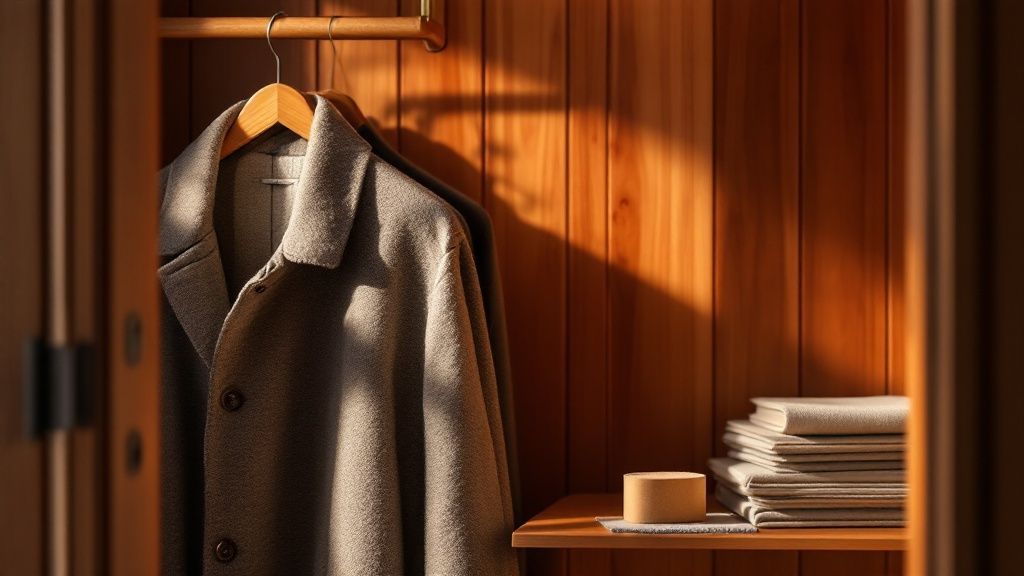Imagine opening your closet to the clean, fresh scent of real wood. That’s the timeless appeal of a cedar closet, prized for its natural ability to protect fine garments. For homeowners, remodelers, and builders in the Bay Area, cedar closet wood is the gold standard for a reason. Its natural oils repel moths, absorb moisture, and deodorize fabrics.
This guide will walk you through everything you need to know about choosing and installing cedar closet wood for your Berkeley, Oakland, or San Francisco home.
Why Cedar Is the Gold Standard for Closets

For builders and homeowners in the Bay Area, cedar is more than just a nice-smelling wood. It’s a smart, long-term investment in your home's quality and the longevity of your clothing. Its unique properties offer benefits that synthetic alternatives just can't match.
The secret is in the oils naturally present in the wood. Unlike chemical mothballs, cedar offers a completely safe, non-toxic way to protect valuable wools and silks. A cedar closet becomes a natural fortress for your wardrobe.
Key Advantages for Bay Area Homes
In our coastal climate, from Berkeley to San Francisco, humidity is a constant battle. This can lead to musty odors and even mildew inside enclosed spaces like closets. Cedar tackles this problem head-on by naturally absorbing excess moisture from the air.
This helps keep the environment inside your closet dry, which means your clothes stay fresher, longer. A cedar-lined closet is also a highly sought-after feature that adds tangible value to a property. The warm tones of the wood bring natural elegance to a utilitarian space, as seen in this beautiful modern cedar addition.
A cedar closet is not just a storage space; it’s a preservation system. By investing in this natural material, you are extending the life of your clothing while enhancing your home's air quality and overall value.
Choosing Your Cedar: Aromatic vs. Western Red
When you start looking into cedar closet wood, you will find two main options. The choice often comes down to Aromatic Eastern Red Cedar and Western Red Cedar. Each brings different benefits suited for various projects and our unique Bay Area microclimates.
Think of Aromatic Cedar as the classic protector of your wardrobe. Western Red Cedar, on the other hand, is valued for its clean, modern look and incredible ability to handle moisture.
Aromatic Eastern Red Cedar: The Scented Guardian
Aromatic Eastern Red Cedar (Juniperus virginiana) is famous for its powerful, fresh scent. Those natural oils actively repel clothes moths and other pests. This is why it has always been the top pick for protecting wool, silk, and cashmere.
From a design standpoint, this cedar has a wonderfully rustic look. It’s known for its vibrant, reddish-pink heartwood with streaks of creamy white sapwood. For a homeowner in Berkeley or Oakland wanting a warm, traditional feel, Aromatic Cedar is the perfect blend of performance and timeless style.
Western Red Cedar: The Moisture Manager
Western Red Cedar (Thuja plicata) shines in a different way, which is especially useful for homes in the damp, coastal climate of the greater Bay Area. Its aroma is more subtle and earthy. Its real superpower is its natural resistance to moisture, mildew, and decay.
This makes it an unbeatable option for closets in basements or near bathrooms. Aesthetically, Western Red Cedar offers a more uniform and contemporary look with its consistent amber-to-brown color. This clean appearance is a favorite for architects and remodelers aiming for a modern, spa-like feel.

As you can see, Aromatic Eastern Red Cedar might be easier on the initial budget. However, the impressive lifespan of Western Red Cedar often makes it a smarter long-term investment for durability in our climate.
Aromatic Eastern Red Cedar vs Western Red Cedar at a Glance
To make your decision easier, let’s compare these two excellent options. Your choice will depend on whether you need top-tier pest control or unmatched moisture resistance. This table provides a side-by-side comparison.
| Feature | Aromatic Eastern Red Cedar | Western Red Cedar |
|---|---|---|
| Primary Benefit | Potent, natural moth and pest repellency. | Excellent moisture and decay resistance. |
| Aroma | Strong, classic "cedar chest" scent. | Mild, subtle, earthy aroma. |
| Appearance | Rustic; red and white streaks with knots. | Uniform; consistent amber and brown tones. |
| Best For | Protecting natural fiber clothing. | Humid environments, modern aesthetics. |
| Bay Area Use Case | Perfect for protecting heirloom woolens in a San Francisco Victorian. | An ideal choice for a closet in a damp Berkeley basement or a sleek, modern remodel. |
Picking the right wood is the foundation of any great project. To learn more about how different woods perform, our guide comparing types of wood for doors and windows is a helpful resource.
5 Major Benefits of a Cedar-Lined Closet

For builders and homeowners across the Bay Area, choosing cedar closet wood is a smart investment. While the clean aroma is its most famous feature, the real advantages go much deeper. They protect your clothing and enhance the space itself.
1. Natural Pest Repellency
The most celebrated quality of cedar is its ability to deter pests. The aromatic oils in the wood create an environment that pests like clothes moths dislike. Instead of harsh chemicals, cedar provides a safe, non-toxic alternative for protecting your best sweaters.
2. Superior Moisture Control
Living in coastal communities like Berkeley means dealing with humidity. Cedar is naturally hygroscopic, meaning it absorbs excess moisture from the air. This helps stop mold and mildew growth before it starts, keeping your clothes fresh. For more on using natural materials, explore our guide on bringing nature inside your home.
3. A Built-In Deodorizer
The classic scent of a cedar closet actively neutralizes other odors. The wood's porous structure traps unpleasant smells from daily wear or stale air. This turns your closet into a self-refreshing space.
A cedar closet works as a natural preservation system. It actively protects garments from pests, moisture, and odors, extending their life and maintaining their quality for years to come.
4. Unmatched Durability
Cedar is a famously durable wood, prized for its natural resistance to decay. The same oils that repel insects also make the wood resilient against fungi and bacteria. A cedar closet is truly built to last a lifetime with minimal maintenance.
5. Increased Home Value
A cedar-lined closet is a high-end feature that adds tangible value to any home. For potential buyers, it signals quality craftsmanship and thoughtful attention to detail. This amenity is often highlighted in real estate listings for a good reason.
How to Select the Right Cedar Materials for Your Project
Choosing the right cedar closet wood at a lumberyard near Oakland can feel overwhelming. Knowing what you're looking for makes all the difference. Your decision will depend on your installation method, budget, and desired final look.
Planks, Panels, or Veneers
When lining a closet, your materials generally fall into three categories. Understanding the trade-offs is crucial for your project.
- Tongue-and-Groove Planks: This is the classic choice for a traditional, high-end look. The interlocking design is straightforward to install and creates a solid, durable surface.
- Large Panels: If speed is your priority, cedar panels are a fantastic option. They cover more area quickly, which can reduce installation time and labor costs.
- Thin Veneers: For tight budgets or odd-shaped spaces, cedar veneers offer the authentic scent and look in a flexible sheet. They are applied with adhesive, making them a cost-effective solution.
Understanding Wood Grades
Next, you'll need to understand wood grading. The grade describes the wood's appearance, specifically the number of knots and color variations. A common high-quality grade you'll see is 'A & Better'.
This grade means the wood is mostly free of knots, giving you a clean, uniform look. It may cost more but delivers a polished finish. Lower grades have more knots and are perfect for a rustic aesthetic.
Inspecting Your Lumber In Person
Nothing beats visiting a trusted supplier in Berkeley to inspect the wood yourself. When picking through the stack, look for a few key details:
- Check for Straightness: Look down the length of each board for warping or bowing.
- Minimize Knots: Unless you want a rustic look, pick pieces with fewer knots.
- Ensure Color Consistency: Pull several boards from the pile to check for color variation.
The global demand for this material reflects its value. According to DataIntelo, the commercial importance of Western Red Cedar is significant, with its market size projected to grow substantially. Taking the time to hand-pick your materials from an eco-friendly lumber supplier in the East Bay ensures your project starts right.
Your Step-by-Step Cedar Closet Installation Guide

You’ve selected your high-quality cedar closet wood, and now it's time for installation. A professional installation requires careful preparation and methodical work. This guide breaks down the process for contractors and skilled homeowners in the Bay Area.
Step 1: Prepare Your Space
Before installing cedar, the closet must be a clean slate. Start by clearing everything out, including shelves, rods, and baseboards. This gives you unobstructed access to the walls.
Next, clean the walls to remove dust or grime. Fill any holes or cracks with spackle, then sand the patches smooth. You need a level foundation for your new cedar.
Step 2: Measure and Plan
"Measure twice, cut once" is key to a smooth job. Accurate measurements prevent costly mistakes and material shortages.
- Measure Wall Area: Calculate the square footage for each wall (height x width) and add them together.
- Account for Openings: Measure the area of the door and subtract it from your total.
- Add a Contingency: It's standard to add 10-15% to your final number. This "waste factor" covers cutting mistakes.
Step 3: Acclimate the Wood
Do not skip this step, especially in the variable Bay Area climate. Wood expands and contracts with temperature and humidity. Acclimating your cedar prevents future warping.
Bring the unopened boxes of cedar into the closet where they will be installed. Let them sit for at least 48-72 hours. This gives the wood time to adjust to your home's environment.
Pro Tip: Never store your cedar in a garage or basement right before installation. For proper acclimation, the wood must be in the same room where it will live permanently.
Step 4: Install the Cedar
With your space prepped, it's time to begin. Always start from the bottom and work your way up. Use a level to snap a straight starting line for your first course of cedar.
Secure the first plank to the wall studs, making sure the "tongue" side faces up. Each new plank will lock into the one below it. For a professional look, stagger the seams from row to row. For help with complex projects, explore our professional installation and maintenance services.
Step 5: Apply Finishing Touches
The final details separate a good job from a great one. Install trim around the door, ceiling, and floor for a clean, polished look. Now you can reinstall your closet rods and shelves. For tips, you might find this guide to installing hanging rails helpful.
Keeping Your Cedar Closet Fresh for Years
Installing cedar closet wood is a fantastic investment. To ensure it keeps working for decades, a little upkeep goes a long way. Over time, the fresh, protective aroma may fade as surface oils dry out.
Thankfully, bringing that famous scent back is simple. The oils are still locked deep inside the wood. With straightforward care, your closet will remain a safe haven for your clothes.
How to Refresh Your Cedar Closet
The most common question we get is what to do when a closet stops smelling like cedar. The fix is easy and doesn't involve expensive products. All you need is a sheet of fine-grit sandpaper (around 150-grit).
Every few years, lightly sand the cedar planks. This action removes the top layer of oxidized wood fibers. It exposes a fresh layer and releases a new wave of aromatic oils.
This simple sanding trick is the best way to rejuvenate your cedar closet. It reactivates the wood's natural pest-repelling and deodorizing powers without adding any chemicals.
Using Cedar Oil and Proper Cleaning
For an extra boost, you can apply a light coat of pure cedarwood essential oil after sanding. Use a small amount on a clean cloth and wipe it onto the wood. Do this sparingly, perhaps once every five to seven years.
For regular cleaning, less is more. Avoid harsh chemical cleaners, waxes, or polishes on your cedar closet wood. These products can clog the wood’s pores, trapping the natural oils inside. A quick dusting is all you need. For more ideas, check out these 8 essential closet organization tips.
Frequently Asked Questions About Cedar Closets
Contractors and homeowners in the Bay Area often have a few questions before starting a cedar closet wood project. Here are the most common questions we hear from builders in Berkeley to remodelers in Oakland. We've provided practical, straightforward answers to help.
How long does the scent of a cedar closet last?
The natural cedar aroma can last for several years. When the scent begins to fade, you can easily refresh it by lightly sanding the wood with fine-grit sandpaper. This simple step releases a fresh wave of protective oils.
Can I install cedar lining over existing drywall?
Yes, absolutely. Cedar planks and panels are designed to be installed directly over existing drywall. Just ensure the wall is clean, dry, and smooth before you begin for the most secure, long-lasting results.
Is cedar closet wood toxic to pets or people?
Aromatic cedar is considered safe for people and most household pets. The natural oils that repel insects are generally not harmful to us. However, proper ventilation during installation is always a good practice.
Do I need to treat or seal a cedar closet?
No, and you should never seal, paint, or varnish the inside of a cedar closet. Applying a finish traps the natural oils inside the wood. This would neutralize its pest-repelling and moisture-absorbing qualities.
What is the cost difference between aromatic and Western Red Cedar?
Generally, Aromatic Eastern Red Cedar is more budget-friendly per square foot. However, Western Red Cedar's superior moisture resistance can make it a better long-term value, especially in damp Bay Area locations like basements or bathrooms. Pricing can vary, so it's best to check with a local lumberyard near Oakland or Berkeley for current costs.
Does cedar repel all types of bugs?
Cedar is most famous for its effectiveness at repelling clothes moths and their larvae. While the strong scent can also deter other common pests like carpet beetles, it is not an all-purpose insecticide. Its primary job is to protect natural fiber clothing from moths.
Ready to bring the timeless quality of cedar to your next project? The experts at Truitt & White have the premium materials and deep knowledge to help. Visit our Berkeley showroom for expert advice.









